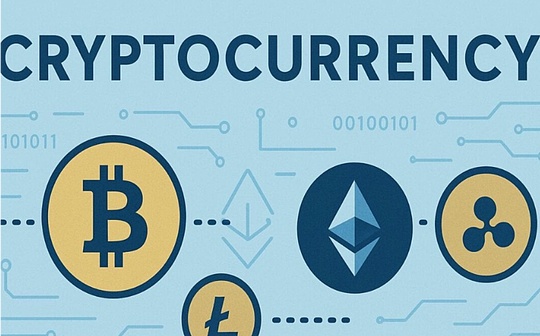
Author: arndxt, compiled by: Luffy
Each cycle has its own unique narrative, and now the market is struggling in conflicting chapters: Bitcoin’s seasonal laws and post-halving dynamics, the Fed’s dovish rhetoric and inflation, and the steepening of the bond market that may signal easing or recession.
We are in a market with drastic volatility:
-
In the short term: Bitcoin may experience volatility that has not yet occurred this year in September.For those willing to downplay seasonal patterns in the year after the halving, a pullback may be a buying time.
-
In the medium term: Fed policy faces the risk of impaired credibility.Rate cuts caused by rising inflation will change the investment landscape.
-
In the long run, the key to the cryptocurrency cycle may not only lie in the flow of retail investors or institutions, but also in the structural health of the corporate cryptocurrency treasury.This is a fragile pillar, and if broken, demand will turn into supply.
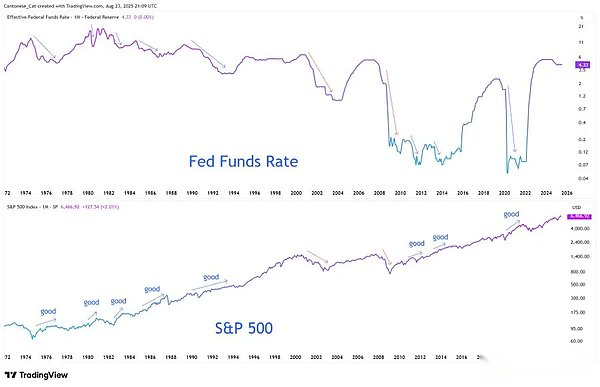 The core logic of investors is simple: we are entering an environment of drastic narrative fluctuations, with seasonal, policy and structural mechanisms pointing in different directions.
The core logic of investors is simple: we are entering an environment of drastic narrative fluctuations, with seasonal, policy and structural mechanisms pointing in different directions.
In the eyes of investors, the signal is not in a single data point, but in the collision of these narratives.
Bitcoin’s “September Ghost” and the reality after halving
Historically, September was the worst-performing month for Bitcoin.The chart shows that the decline caused by the liquidation of long positions has occurred repeatedly.But this cycle is different from the past: we are in the year after halving, and the third quarter of these years in history tends to be bullish.
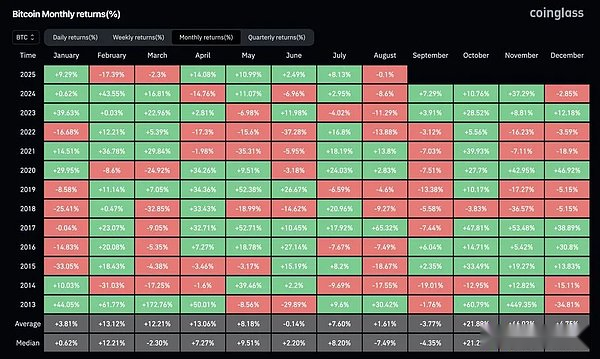 There has not been a single-month increase of more than 30% (or even 15%) so far in 2025, which means that volatility has been compressed.In every bull market, the surge will appear in a concentrated manner.There are four months left this year, and the question is not whether volatility returns, but when will it return.Investors’ conclusion is: If there is a pullback in September, it may become the last important entry window before the inevitable rise in the fourth quarter.
There has not been a single-month increase of more than 30% (or even 15%) so far in 2025, which means that volatility has been compressed.In every bull market, the surge will appear in a concentrated manner.There are four months left this year, and the question is not whether volatility returns, but when will it return.Investors’ conclusion is: If there is a pullback in September, it may become the last important entry window before the inevitable rise in the fourth quarter.
The Fed’s narrative split
Powell’s speech at Jackson Hall was widely misunderstood as the green light of radical ease.In fact, his statement is more subtle: He left a hole for the rate cut in September, but stressing that this does not mark the beginning of a loose cycle.
Regarding the labor market, Powell acknowledged that there was a “strange balance”: both labor supply and demand slowed down, leaving the market in a vulnerable state.Risks are asymmetric and if this balance is broken, it may explode quickly in the form of layoffs.
Regarding inflation, he bluntly said: Tariffs have obviously pushed up prices and the impact will continue to accumulate.Although Powell called it a “one-time change in price levels”, he stressed that the Fed cannot allow inflation expectations to get out of control.
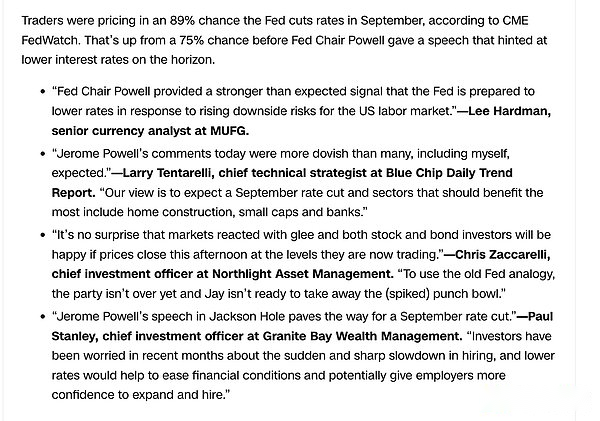 The transformation of the framework is more revealing.The Federal Reserve officially abandoned the “average inflation target system” in 2020 and returned to the 2012 “balanced path” model: no longer tolerate inflation above 2%, and no longer focuses only on unemployment.In other words, even if the market has digested the almost inevitable rate cut, the Fed is still sending signals that it has a stricter interpretation of the 2% inflation target.
The transformation of the framework is more revealing.The Federal Reserve officially abandoned the “average inflation target system” in 2020 and returned to the 2012 “balanced path” model: no longer tolerate inflation above 2%, and no longer focuses only on unemployment.In other words, even if the market has digested the almost inevitable rate cut, the Fed is still sending signals that it has a stricter interpretation of the 2% inflation target.
The contradiction is that the Federal Reserve is preparing to cut interest rates in a stagflation environment and loosens when core inflation accelerates and labor markets are weak.Why?Because from a structural perspective, the debt burden of the United States makes high interest rates unsustainable both politically and financially.Powell could talk about credibility, but the system was trapped in a vicious cycle: spending, borrowing, printing money, and repeating itself.
For investors, the key conclusion is: credibility risk has now become asset pricing risk.If the 2% target is reduced from an anchor to a “vision”, it will reset the valuation of bonds, stocks and hard assets.In this environment, scarce assets will make products (Bitcoin, Ethereum, gold) a reasonable choice to hedge against dilution risks.
Signals of steepening of bond markets
The yield curve has quietly lifted the inversion: the 10-year and 2-year U.S. Treasury spread rebounded from one of the deepest inversions in history to +54 basis points.On the surface, this looks like normalization and the curve is healthier.
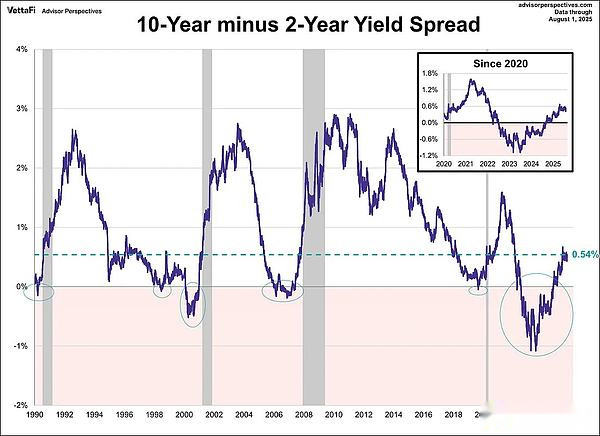 But history gives different warnings.In 2007, the steepening after the curve was inverted was not a “safety signal” but a precursor to collapse.The key lies in the reason for the steepening of the curve: if the growth expectations improve, it is bullish; if the short-term interest rate falls faster than long-term inflation expectations, it indicates that the risk of recession is approaching.
But history gives different warnings.In 2007, the steepening after the curve was inverted was not a “safety signal” but a precursor to collapse.The key lies in the reason for the steepening of the curve: if the growth expectations improve, it is bullish; if the short-term interest rate falls faster than long-term inflation expectations, it indicates that the risk of recession is approaching.
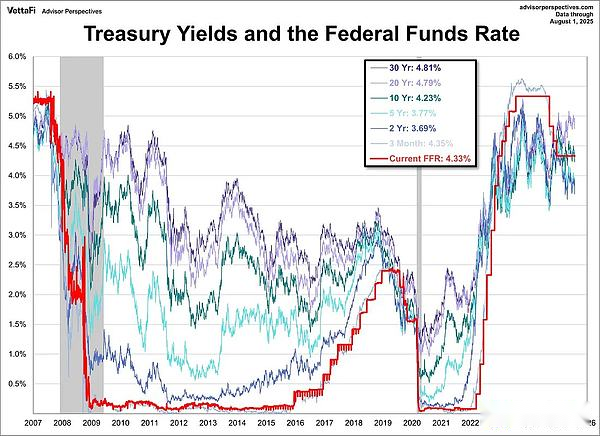 At present, the curve is steepering due to the wrong reasons: the market turns the expectation of interest rate cuts into sticky inflation.This is a fragile pattern.
At present, the curve is steepering due to the wrong reasons: the market turns the expectation of interest rate cuts into sticky inflation.This is a fragile pattern.
Structural issues of cryptocurrencies
Against this macro background, cryptocurrencies face their own survival test.”Enterprise treasury hoarding” (MSTR, Metaplanet, ETH-holding companies, etc.) has always been the core demand pillar.But as net value premiums shrink, the danger is that these entities may turn to discounts, from buyers to forced sellers.
The cycle does not end with narrative demise, but with the reversal of the mechanisms that drive demand.2017 is an ICO, 2021 is DeFi/NFT leverage, and 2025 may be the cryptocurrency treasury hits the limits of balance sheet arbitrage.
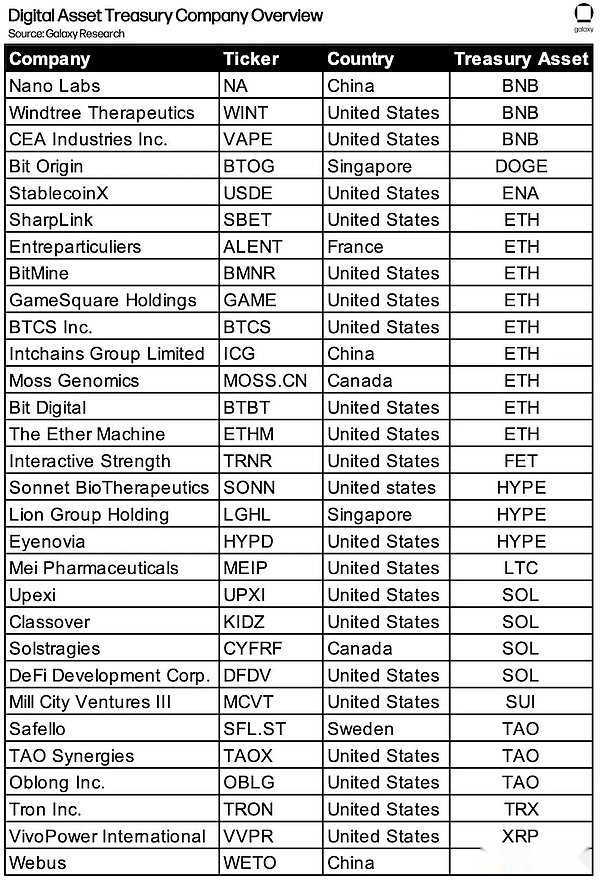
Overall, the narrative core of this cycle is “disharmony”: the market is pulled in the opposite direction by seasonal, policy and structural mechanisms.
-
Bitcoin’s September pullback collided with the inevitable rise after the halving;
-
The Fed made cautious remarks, but was forced to cut interest rates against the backdrop of stagflation;
-
The steepening of the bond market seems to be alleviating, but it exudes fragility;
-
The fuel of cryptocurrencies themselves – the storage of treasury, faces the risk of being converted to liquidation.
For investors, the logic is simple: we are in an era of narrative collisions, and premiums belong to those who can foresee breakthroughs, hedge dilutions, and regard volatility as the only real normal volume.
Opportunity is not about choosing a certain narrative, but about realizing that volatility itself is an asset.

